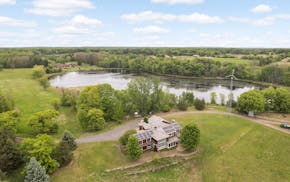It's been a tough year for the 160 acres of sweet corn that Dave Nathe grows near Elk River, Minn. And as the last weeks of a hot, dry season approach for this staple of late-summer barbecues, he's worried things could still get worse.
"It's never been this dry for this long," Nathe said. "There's been some spotty showers where some farms will catch an inch, 2 inches. But we haven't caught anything in weeks."
As sweet corn reaches its seasonal peak, filling roadside stands and grocery shelves, the quantity and quality is being shaped by drought in much of the Midwest.
At some farmers markets and co-op grocery stores that rely heavily on sweet corn grown in areas around the Twin Cities, there's less supply, and higher prices, at least at certain times.
"I've had less I'm able to sell this summer," said Cher Yang, who grows corn on a plot of land in Rogers and sells it at the Minneapolis Farmers Market. He doesn't have dedicated irrigation but has taken to watering it himself. "This year has been very hard — it's regrow, regrow, regrow, water, water, water."
Yang raised his prices this year over last, to $5 for eight ears of corn compared with $5 for a dozen.
But the food chain is complex. Most of the sweet corn Minnesotans eat comes from somewhere else. And most of the sweet corn Minnesota farmers grow gets processed into canned products or as ingredients in other foods.
Since 1980, Nathe has run Riverside Farms, a family business that supplies sweet corn and other vegetables to farmers markets and grocery stores around the Twin Cities, including Lunds & Byerlys.
Nathe uses an irrigation system that pulls water from the Mississippi River, but he is worried the state Department of Natural Resources might make him turn it off if the weather stays dry into September.
At smaller farms without fixed irrigation systems, it's been even more of a struggle.
"There's decision fatigue for a lot of farmers around what to water and when right now," said Natalie Hoidal, who researches local vegetable production for University of Minnesota Extension. "Most of the smaller growers don't have a significant irrigation infrastructure. Sweet corn, because it's a little more drought tolerant, sometimes gets a little left behind. So we're probably seeing impacts of that now."
Chris Utecht, another Minneapolis market vendor who raises sweet corn near New Richmond, Wis., has 12 acres on irrigated land owned by a friend, and another 5 acres on his own land. He doesn't have irrigation for that plot, but this year installed a temporary watering system known as drip tape.
The irrigated corn "is beautiful," Utecht said. By contrast, he said, his first two plantings on the non-irrigated land produced lackluster corn. It improved after he started watering it more, but it's not a permanent solution.
"Our well is not meant to be irrigating 5 acres," Utecht said. "It's meant to provide water for the barn."
Slowed-down sweet corn production doesn't necessarily mean lack of availability at grocery stores.
"We're swimming in sweet corn right now," Emerson Sample, the assistant produce manager at Seward Co-op in Minneapolis, said late last week. "We've got it going for 99 cents an ear, which is about as low as we get."
Seward buys local when it can, Sample said, but will supplement that with out-of-state purchases if needed. Bigger grocery chains are even more likely to buy sweet corn from around the country, said Charlie Rohwer, a researcher at the University of Minnesota's Southern Research and Outreach Center in Waseca.
"If you're buying sweet corn at Cub Foods, there's a good chance it came from Florida or Texas or Indiana or Missouri," Rohwer said.
Minnesota is the country's No. 1 producer of sweet corn for processing — the stuff that's bought by food companies for commercial canning and freezing. But it's not even in the top 20 for market sweet corn.
Most of the sweet corn for processing is grown in southeast and south-central Minnesota, Rohwer said, where the effects of this year's drought have been felt the least. It's mostly grown without irrigation, he said, because it doesn't have to look as good on the cob, which is one of the benefits of regular watering.
Jerry Untiedt hasn't been real happy with the look of a lot of his corn this year. The owner of Untiedt's Vegetable Farm, he grows sweet corn in Waverly and Montrose, and is the supplier for the sweet corn concession at the Minnesota State Fair, which sells about 200,000 ears a year.
"If you peel back the tip a little bit, that area should be filled with kernels out to the very end. But if it's short of moisture, that doesn't happen," Untiedt said. "That affects the aesthetic more than the flavor, but you know us Americans — we eat with our eyes and we only like the best of the best."
Untiedt said his sweet corn production has been "up and down" this year. But he's not worried about harvesting enough to fulfill the fair's order.
"This isn't my first time at the rodeo," Untiedt said.

Minnesota Department of Health rescinds health worker layoffs

Eco-friendly house on 30 acres near Marine on St. Croix listed at $1.6M

DOGE cuts federal money for upgrades at Velveeta plant in New Ulm

